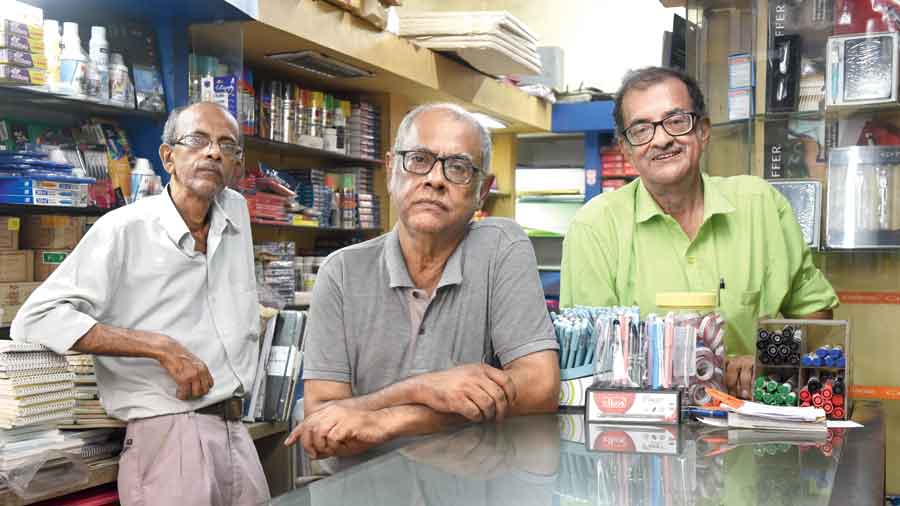Stationery promises order. Buying pens, paper or notebooks makes you feel it is possible to organise your dispersed thoughts, your scattered life. Files, clips or glue can suggest that it is possible to organise your documents, which are sometimes more scattered than your life. Stationery gives you a sense of purpose, in a way the icons on your laptop screen can never.
For many children stationery also happens to be more fun — and more solid — than lessons at school. Especially now, after the explosion of products and packaging, when stationery is often being mistaken for gift items.
All of this is on display as you walk into Ganguly Paper Centre in Jamir Lane, Ballygunge, south Kolkata. But as you enter the shop that is like a long, narrow passage, what you perhaps notice most is a sense of comfort, which comes from the stationery, and also from the men managing the store.
Four brothers have been managing the store, which they started in 1981. The eldest of the Ganguly brothers, Prithwish, 76, does not come to the shop anymore, because of health reasons.
The other three brothers, Sushanta, 70, Suprabhat, 65, and Subrata, 61, run the shop, are at the counter every day from morning to evening. Between them they share a kind of harmony that is undisturbed by the occasional flurry as a customer comes in and an envelope of a particular size is produced in a jiffy after a brief and intense discussion between the brothers.
The shelves, a happy combination of old and new stationery, are a register of the change of the last four decades. But tell the Gangulys that their shop is anything other than the most mundane place, you are met with stout denials.
“Stationery is a vast world. We are like a drop in the ocean,” begins Sushanta. Suprabhat speaks less. Subrata is not at the store that afternoon.
Like his brothers, Sushanta is a humble, polite and friendly man. He has a theory of change, which enables him to accommodate the new almost unproblematically.
“We have no speciality and what we store now we always did: school stationery, paper and fine arts materials, such as water colours, oils and acrylics,” says Sushanta. The store is frequented by artists or those interested in art.
“But you too had all of these. Now, children are being dazzled with many more products,” he says.
Which, he says, is not necessarily a bad thing. Stationery has come alive. “Product designers have been brilliant,” he says.
The new designs have created new demand, and at the same time products have become more affordable.
Things have disappeared. “When we began we used to sell paper for the letter press. From the 90s we shifted to computer paper,” says Sushanta.
Gem clips and simple pins have gone. Pens have proliferated: you have highlighters, markers, microtip pens. The Rotring pen used in drawing for engineering has become finer and requires less control by hand.
Fountain pens are bought usually by customers who are above 45.
“We have noticed that the way a pen is held has changed. We used to place the index finger near the nib of the and the pencil. That way you could acquire a good handwriting. Now the pen is held as if by all fingers,” says Sushanta.
But that should not make us conclude that all is lost. “Notebooks continue to be in demand. And the geometry box remains the same,” says Sushanta. The geometry box remains as central to stationery as mathematics is to our educational foundation, he feels.
We should also conclude that we have lost the quality of earlier products.
“We cannot say whether the products are better or worse, because price is a factor. Why should we keep talking about quality if we can’t afford it? Now products come in many price brackets.”
The brothers to have favourites among what is at the store. But they do mention the “fine arts” items, which came to be there because of their youngest brother, Subrata.
“He is an artist,” says Suprabhat proudly. Subrata studied visual and commercial arts at Rabindra Bharati University. All the other brothers studied commerce, “though our eldest brother’s interest was in engineering”, says Sushanta, who remembers his years at St Xavier’s College fondly.
“So our strengths are very evenly distributed, between arts and commerce,” laughs Sushanta. “One person can’t run the show,” he says. Procuring the items can be hard work. The marketplace can be rough and physically exhausting, though most of the items are delivered now.
The shop demands no rigorous daily routine, though. “Except the morning and evening prayers and some dusting,” says Sushanta. “Everything is in place,” he adds proudly.
“Those who will run this place later will have no problem at all.”
He does not think of the future. “We are all very fit,” he says Sushanta. “We have no major health problems.” They lead a simple life.
Every morning after having breakfast at home, they reach the store around 11 and stay on till evening.
“We don’t have fast food at all. We don’t have lunch either if we are at the store. Just have tea and something small. We hardly eat out or have late nights,” says Sushanta. “We lead an orderly life.”
It is rather appropriate for the store they run.
